Abstract
The study is an analysis in a comparative evolution on the importance that Romanian population, respectively the generations in its composition, attribute to some item/values that must be given priority in our country in the next 10 years, such as: Maintaining order in the country and Fighting rising prices, both associated with materialism dimension, respectively Giving people more say in important government decisions and Protecting freedom of speech, both associated with postmaterialism dimension. In order to ensure the uniformity of the comparative analytical approaches, for the analysis of general trends, indicators that have been used were taken from waves of the international data base World Values Survey (WVS 1998, WVS 2005 and WVS 2012) and a wave of the international data base European Values Survey (EVS 1999), on triple generations with the age of under 29 years old, 30-49 years old, respectively over 50 years old. For the intergenerational and intragenerational analyzes, indicators that have been evaluated were taken from two waves of the international database World Values Survey (WVS 2005 and WVS 2012), on triple generations with the age of under 29 years old, 30-49 years old, respectively over 50 years old. The result of the statistic process reveals tendencies both in the sense of increasing - the postmaterialism dimension and decreasing - the materialism dimension, being observable, especially among younger generations, a tendency towards a more postmaterialistic profile.
Keywords: Materialismpostmaterialismintergenerational replacement
Introduction
The theory of value change holds that the existence of a sufficient level of economic and physical security, experienced for a period of at least 15 years at the level of a society, determines a gradual value translation from the satisfaction of some material objectives / goals to some related to self-expression, freedom, quality of life, categorized as postmaterialist (Inglehart & Abramson, 1995; Inglehart & Welzel, 2005).
Establishing the trends of manifestation of the relationship materialism - postmaterialism at the level of a society or of the generations from its composition, can be achieved through the identification / establishment of the major objectives of the population, choosing between materialistic priorities, such as: maintaining order in the country and fighting rising prices, respectively postmaterialist priorities, such as: giving people more say in important government decisions and protecting freedom of speech (Inglehart, 2008).
The choice of options maintaining order in the country and fighting rising prices, denotes a materialistic value orientation, the emphasis being on ensuring physical and material security, while choosing items giving people more say in important government decisions and protecting freedom of speech denotes a postmaterialist value orientation (Inglehart, 1971; Inglehart & Norris, 2011).
To this end, the World Values Survey and European Values Survey (abbreviated throughout the paper as WVS and WVS) public opinion research programs have included a number of items designed to indicate the predominant individual values between those related to physical and material security called materialist and those related to expression and self-expression, also called postmaterialist.
Problem Statement
In order to identify whether the Romanian cultural profile could change over the next years, it is important to analyze if the materialism-postmaterialism ratio is stable in time or under the natural intergenerational replacement there can be observe an increasing or decreasing trend.
Research Questions
The main research questions of our study regarding the evolution of materialism-postmaterialism ratio are:
Is the Romanian materialism-postmaterialism ratio stable in time? And if not, in what direction is it moving?
Are there intergenerational differences? And if so, in what directions?
Are there intragenerational differences? And if so, in what directions?
Purpose of the Study
The purpose of this paper is to analyze from a quantitative perspective the dynamics of the Romanian materialism-postmaterialism ratio and to observe whether significant changes have occurred in the past 15 years, based on a comparative intergenerational and intragenerational analyze.
Research Methods
The present study is a meta-analysis in comparative progression on the importance that the Romanian population, respectively the generations in its composition, attribute to some items / values that must be given priority in our country in the next 10 years, such as: Maintaining order in the country, Fighting rising prices, Giving people more say in important government decisions, namely protecting freedom of speech.
The hypothesis of the comparative approach is that the younger generations in Romania share to a greater extent value orientations associated with the postmaterialist dimension (Associated items: Giving people more say in important government decisions and Protecting freedom of speech) and in to a lesser extent value orientations associated with the materialist dimension (Associated items: Maintaining order in the country and Fighting rising prices), compared to older generations.
In the situation of identifying such an intergenerational trend, it is relevant to observe the extent to which these differences are maintained over time (through the analysis of global trends and intragenerational trends) and thus can be classified as
On the other hand, if we are in the situation of
In this regard, for each of the four Items associated with the relationship materialism - postmaterialism (Inglehart, 1971), three distinct types of analysis were carried out, on the following coordinates:
- longitudinal analysis in order to identify the global trend - at the level of the entire population - of manifestation in the period 1998 - 2012 of the two mentioned dimensions (materialism and postmaterialism), based on World Values Survey - (WVS 1998, WVS 2005 and WVS 2012) and European Values Survey - (EVS 1999);
- longitudinal intragenerational analysis - in order to identify the changing trends of the two mentioned dimensions (materialism and postmaterialism) for each of the generations under 29 years, 30-49 years, and over 50 years, based on World Values Survey data (WVS 2005 and WVS 2012);
- cross intergenerational analysis (two time points of comparison represented by the waves WVS 2005 and WVS 2012), in order to comparatively observe the generations under 29 years, 30 - 49 years, respectively over 50 years.
In order to ensure the uniformity of the comparative analytical approaches, for the analysis of global trends, indicators measured / evaluated through four waves of international databases were taken into account, as follows: WVS 1998, WVS 2005, WVS2012, respectively EVS 1999.
For the intergenerational and intragenerational analyzes, indicators measured / evaluated through two waves of the international database World Values Survey (WVS 2005 and WVS 2012), were taken into account, by triples generation under 29 years, 30-49 years, respectively over 50 years.
Findings
Materialism dimension
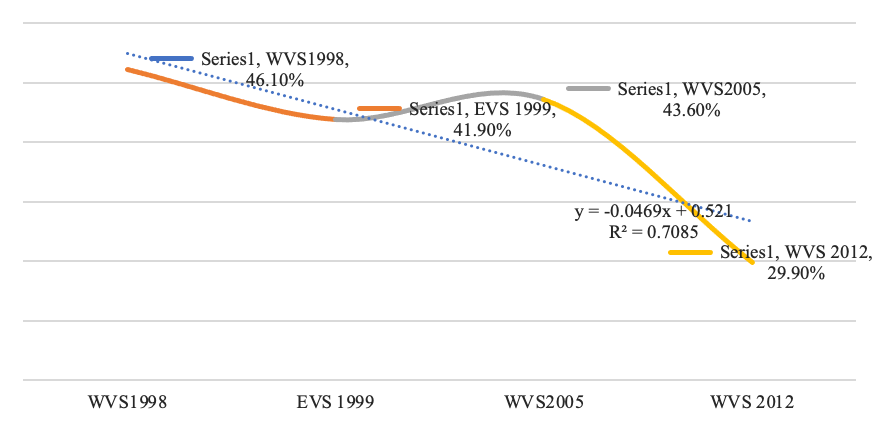
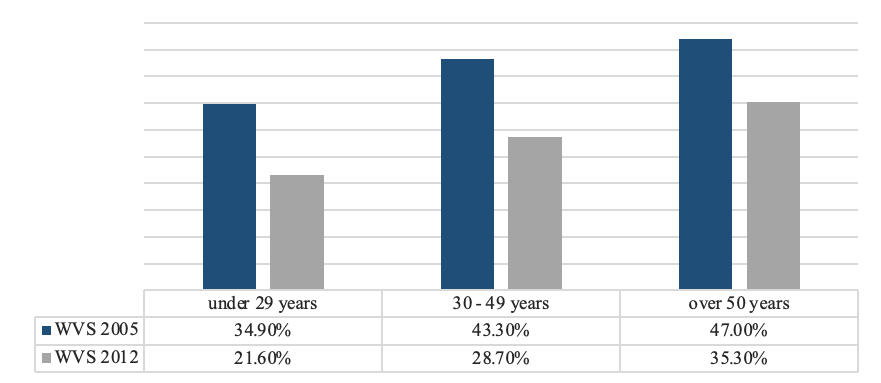
- Under 29 years and 30 - 49 years - the difference in absolute terms between the two generations is 8.4 percentage points, the confidence interval associated with the difference (95% CI) does not include the value 0 (5.19 to 11.58), and the significance threshold associated is p <0.0001;
- 30 - 49 years and over 50 years - the difference in absolute terms between the two generations is 3.7 percentage points, the confidence interval associated with the difference (95% CI) does not include the value 0 (0.42 to 6.96), and the significance threshold associated is p <0.0001;
- Under 29 years and over 50 - the difference in absolute terms between the two generations is 12.1 percentage points, the confidence interval associated with the difference (95% CI) does not include the value 0 (8.87 to 15.28), and the associated significance threshold is p <0.0001.
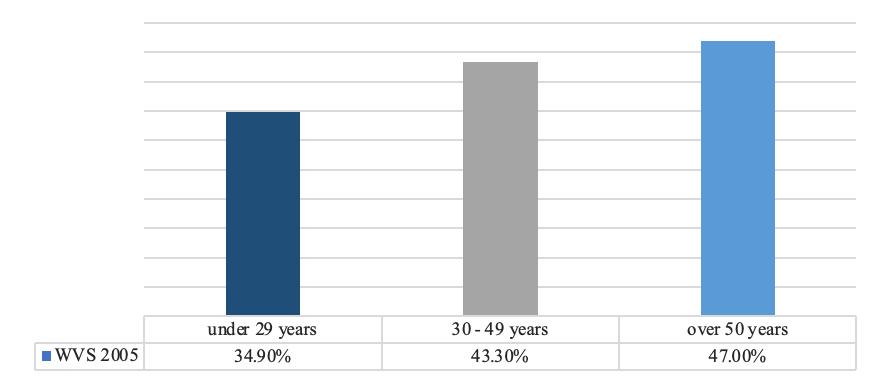
It is noted that, for the year 2005, the materialism dimension has a statistically significantly lower level at the level of the younger generations compared to the older generations (Figure
- Under 29 years and 30 - 49 years - the difference in absolute terms between the two generations is 7.1 percentage points, the confidence interval associated with the difference (95% CI) does not include the value 0 (4.00 to 10.18), and the significance threshold associated is p <0.0001;
- 30 - 49 years and over 50 years - the difference in absolute terms between the two generations is 6.6 percentage points, the confidence interval associated with the difference (95% CI) does not include the value 0 (3.26 to 9.91), and the significance threshold associated is p <0.0001;
- Under 29 and over 50 - the difference in absolute terms between the two generations is 13.70 percentage points, the confidence interval associated with the difference (95% CI) does not include the value 0 (10.49 to 16.86), and the associated significance threshold is p <0.0001.
It is noted that (Figure
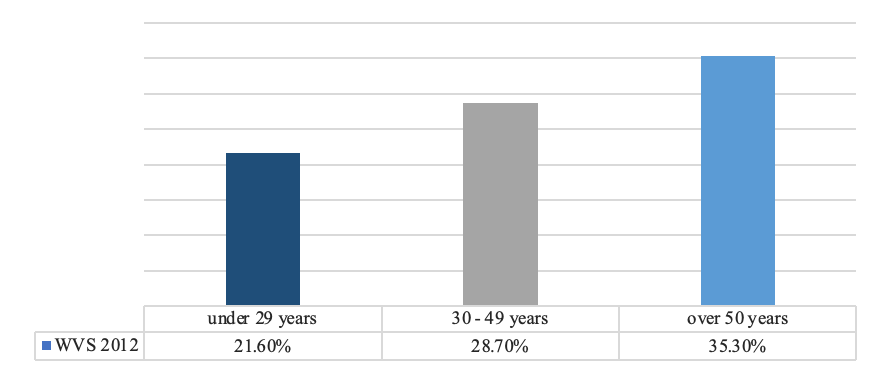
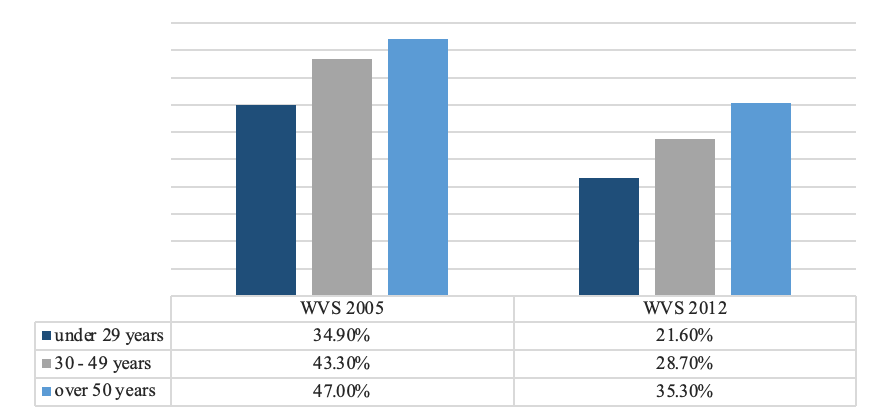
In conclusion, it can be stated that the results of the statistical processing reveal:
-
-
-
Postmaterialism dimension
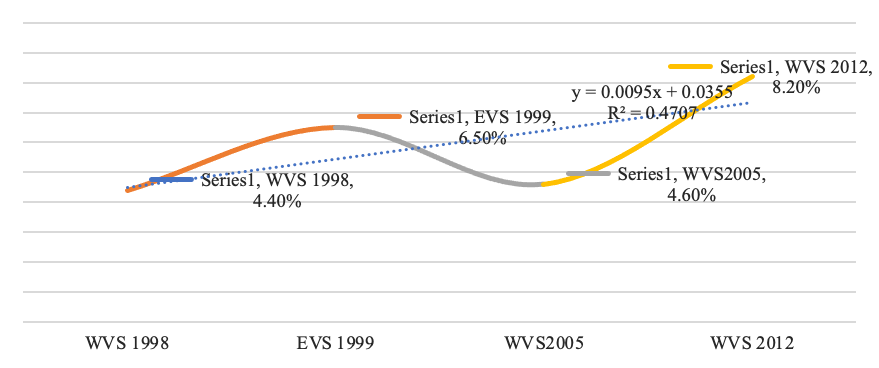
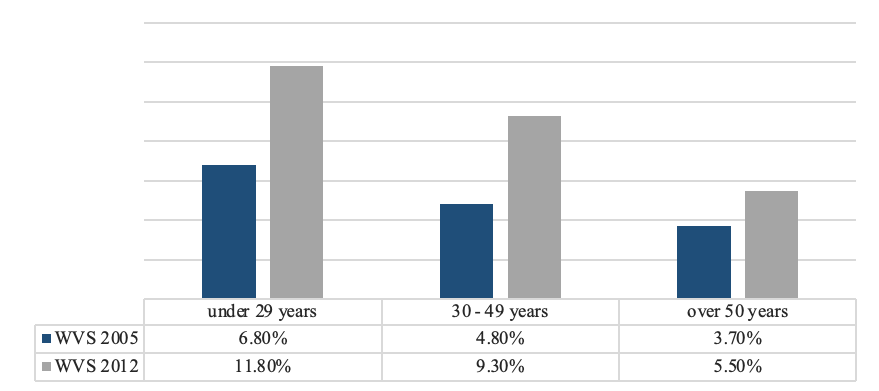
- Under 29 years and 30-49 years - the difference in absolute terms between the two generations is 2 percentage points, the confidence interval associated with the difference (95% CI) does not include the value 0 (0.46 to 3.55), and the significance threshold associated is 0.0108;
- 30 - 49 years and over 50 years - the difference in absolute terms between the two generations is 1.1 percentage points, the confidence interval associated with the difference (95% CI) includes the value 0 (-0.23 to 2.44), and the significance threshold associated is 0.1042;
- Under 29 years and over 50 years - the difference in absolute terms between the two generations is 3.1 percentage points, the confidence interval associated with the difference (95% CI) does not include the value 0 (1.63 to 4.58), and the associated significance threshold is p <0.0001.
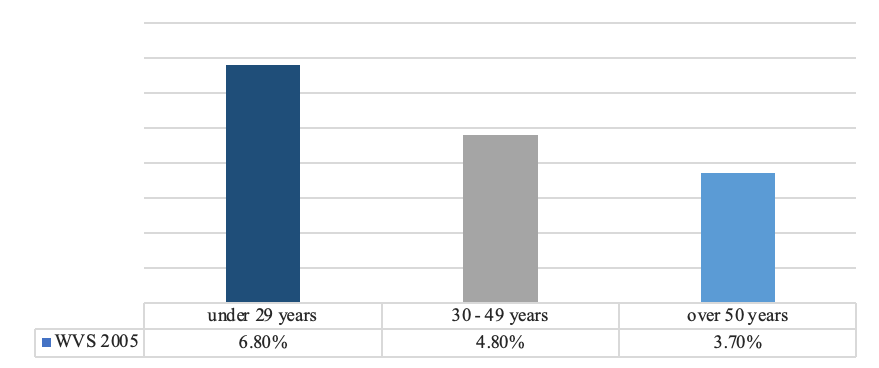
It is noted that, for 2005, the postmaterialism dimension has a statistically significant higher level in the younger generations compared to the older generations, except for the statistically insignificant difference between the 30-49 generation and over 50 generations. years.
- Under 29 years and 30 - 49 years - the difference in absolute terms between the two generations is 2.5 percentage points, the confidence interval associated with the difference (95% CI) does not include the value 0 (0.30 to 4.70), and the significance threshold associated is 0.0257;
- 30 - 49 years and over 50 years - the difference in absolute terms between the two generations is 3.8 percentage points, the confidence interval associated with the difference (95% CI) does not include the value 0 (1.93 to 5.68), and the significance threshold associated is 0.0001;
- Under 29 years and over 50 years - the difference in absolute terms between the two generations is 6.3 percentage points, the confidence interval associated with the difference (95% CI) does not include the value 0 (4.30 to 8.31), and the associated significance threshold is p <0.0001.
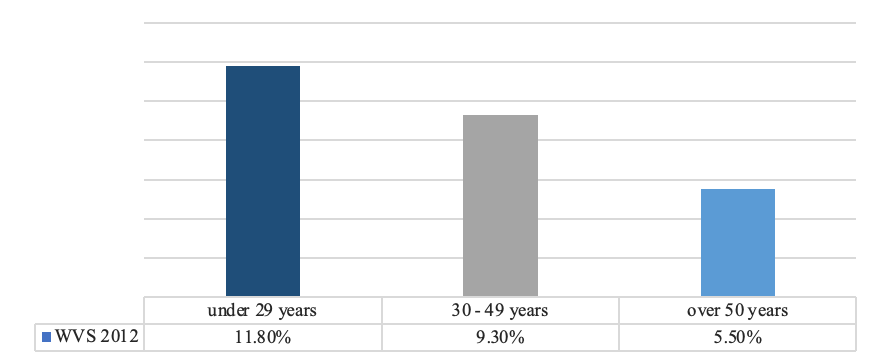
It is noted that, for 2012, the dimension of postmaterialism has a statistically significant higher level in the younger generations compared to the older generations.

-
-
-
Conclusion
The results of the statistical processing performed at the level of the materialism - postmaterialism relationship highlight the following aspects:
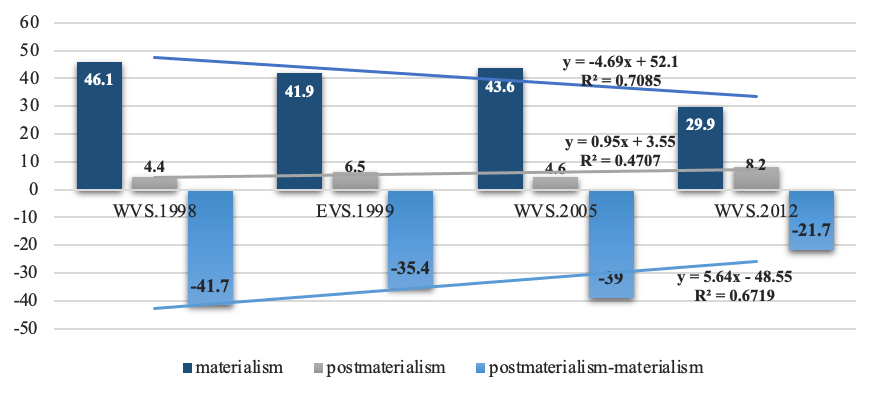
Thus, a common dimension of the materialism-postmaterialism relationship was created, which highlights the constantly increasing trend of the difference between the percentage of postmaterialists and that of materialists in Romanian society, between 1998 and 2012 (Figure
The intergenerational analysis, carried out from the perspective of observing the extent to which we are witnessing a phenomenon of translating the tendencies of increase or decrease from one generation in one wave to the next generation in the next wave, reveals the following:
- a tendency to translate the increase of the level of the postmaterialism dimension from the generation under 29 years old from the wave 2005 to the generation 30-49 years from the wave 2012. Similarly, there is a translation of the increase in the level of the dimension of postmaterialism from the generation 30-49 years of the 2005 wave to the generation over 50 years of the wave 2012;
- a tendency to translate the decrease of the level of the materialism dimension from the generation under 29 years old from the wave 2005 to the generation 30-49 years from the wave 2012, respectively from from the generation 30 - 49 years of the wave 2005 to the generation over 50 years of the wave 2012.
Concluding, it can be observed that, both at the level of the materialism dimension and the postmaterialism dimension, the translation of the decreasing, respectively increasing tendencies, takes place at the level of all generations in consecutive waves of the World Values Survey.
This state of affairs, over time, against the background of the natural replacement of generations, leads to a change in the relationship materialism - postmaterialism that characterizes the Romanian society as a whole.
References
- Inglehart, R. (1971). The Silent Revolution, Changing Values and Political Style among Western Publics. Princeton University Press.
- Inglehart, R., Welzel, C. (2005). Modernization, Cultural Change and Democracy, The Human Development Sequence. Cambridge University Press.
- Inglehart, R., Norris, P. (2011). Sacred and Secular: Religion and PoliticsWorldwide, 2nd Edition. Cambridge University Press.
- Inglehart, R. (2008). Changing Values Among Western Publics from 1970 to 2006. West European Politics, 31, 130-146. DOI:
- Inglehart, R., & Abramson, P. R. (1995). Values Change in global perspective. The University of Michigan Press.
Copyright information

This work is licensed under a Creative Commons Attribution-NonCommercial-NoDerivatives 4.0 International License.
About this article
Publication Date
31 March 2021
Article Doi
eBook ISBN
978-1-80296-103-4
Publisher
European Publisher
Volume
104
Print ISBN (optional)
-
Edition Number
1st Edition
Pages
1-536
Subjects
Education, teacher, digital education, teacher education, childhood education, COVID-19, pandemic
Cite this article as:
Sever, G. I., & Vasile, C. (2021). The Romanian Materialism-Postmaterialism Ratio - Comparative Analysis. In I. Albulescu, & N. Stan (Eds.), Education, Reflection, Development – ERD 2020, vol 104. European Proceedings of Social and Behavioural Sciences (pp. 68-79). European Publisher. https://doi.org/10.15405/epsbs.2021.03.02.8

